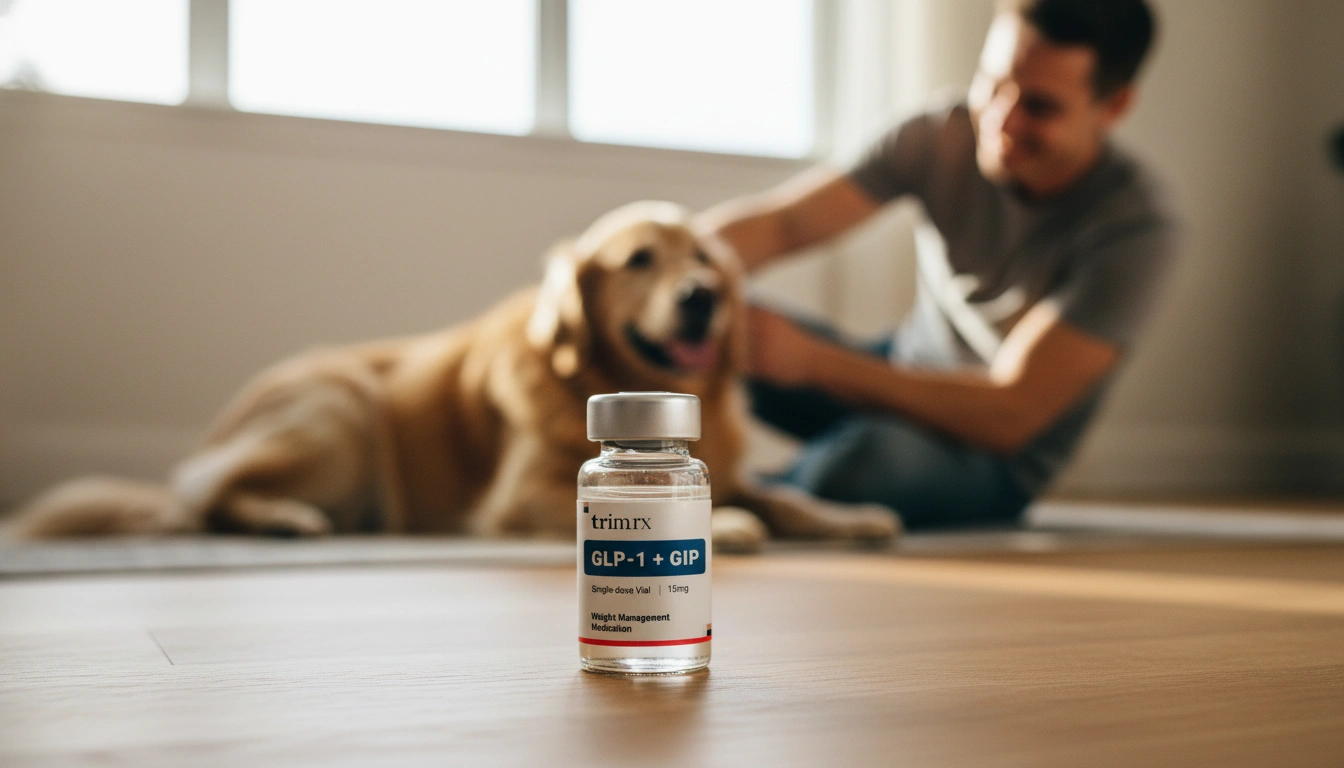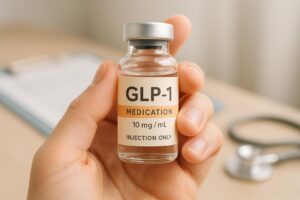How to Give a GLP-1 Injection: A Comprehensive Guide

Introduction
Did you know that managing Type 2 diabetes and obesity can be significantly enhanced by learning how to properly administer GLP-1 injections? These medications, including Semaglutide and Tirzepatide, are designed to help individuals achieve better control over blood sugar levels and support weight loss. As more people turn to these innovative treatments, understanding how to give a GLP-1 injection becomes crucial for maximizing their effectiveness and ensuring a positive experience.
At TrimRx, we believe in empowering our clients with the knowledge and tools they need to succeed on their weight loss journeys. By merging cutting-edge telehealth innovations with personalized care, we strive to make sustainable weight loss attainable for everyone. In this blog post, we will delve into the step-by-step process of giving a GLP-1 injection, the significance of proper technique, and best practices to enhance your experience. Together, we will explore everything you need to know to administer these injections confidently and effectively.
By the end of this guide, you will have a comprehensive understanding of how to give a GLP-1 injection, including necessary preparations, techniques, and tips for ensuring safety and comfort. We’ll also discuss the importance of site selection and rotation, the supplies you’ll need, and common mistakes to avoid. So, let’s get started on this journey to better health and well-being!
Understanding GLP-1 Injections
What are GLP-1 Injections?
GLP-1 (glucagon-like peptide-1) injections are medications that mimic the effects of a naturally occurring hormone in the body. This hormone plays a key role in regulating blood sugar levels by stimulating insulin secretion, decreasing appetite, and slowing gastric emptying. The primary GLP-1 medications available include Semaglutide (Ozempic® and Wegovy®), Tirzepatide (Mounjaro®), and others.
Who Should Use GLP-1 Injections?
GLP-1 injections are typically prescribed for individuals with Type 2 diabetes or obesity, especially when lifestyle changes and oral medications have not yielded satisfactory results. If you are considering GLP-1 therapy, it’s crucial to consult with a healthcare professional to determine if this treatment option is suitable for you.
Benefits of GLP-1 Injections
- Weight Loss: GLP-1 medications can support weight loss by reducing appetite and enhancing feelings of fullness.
- Blood Sugar Control: These injections help manage blood sugar levels, which is essential for individuals with diabetes.
- Improved Metabolic Health: GLP-1 medications can contribute to overall metabolic health by influencing insulin sensitivity and glucose metabolism.
The Role of TrimRx in Your Weight Loss Journey
At TrimRx, we provide a personalized assessment quiz that helps determine if you qualify for our prescription weight loss medications, including GLP-1 injections. Our comprehensive service includes doctor consultations, medication, lab work, unlimited support, and shipping—all designed to make your weight loss journey effective and enjoyable. If you’re interested in exploring our personalized weight loss programs, we encourage you to take our free assessment quiz here.
Preparing for Injection
Supplies You Will Need
Before you start, gather the following supplies:
- GLP-1 medication vial: Ensure the medication is within its expiration date and has been stored properly.
- Syringe and needle: Use a syringe that is appropriate for the dose prescribed by your healthcare provider.
- Alcohol swabs: To clean the injection site and the top of the medication vial.
- Sharps container: For safe disposal of used needles.
Hand Hygiene
Start by washing your hands thoroughly with soap and water. This is a crucial step to minimize the risk of infection.
Cleaning the Vial
Using an alcohol swab, clean the rubber stopper of the medication vial. This step is important to prevent contamination as the vial is accessed.
Check the Medication
Before drawing the medication, check the vial to ensure there are no visible particles or discoloration. If you notice anything unusual, do not use it and consult your healthcare provider.
Drawing Up the Medication
Filling the Syringe
-
Prepare the Syringe: Uncap your syringe and pull back the plunger to draw air into the syringe, equal to your prescribed dose.
-
Insert the Needle: Puncture the rubber stopper of the vial with the needle and push the plunger to inject the air into the vial. This creates a vacuum that makes it easier to draw the medication.
-
Draw the Medication: Invert the vial and slowly pull back on the plunger to draw the prescribed amount of medication into the syringe. If you see air bubbles, gently tap the syringe to move the bubbles to the top, then push the plunger slightly to expel them.
-
Remove the Needle: Once you have the correct dose, carefully withdraw the needle from the vial.
Preparing for Injection
- Recap the Needle: If you’re not ready to inject immediately, recap the needle until you are prepared to proceed.
- Do Not Reinsert the Needle into the Vial: This helps maintain the sterility of the syringe.
Administering the Injection
Choosing the Injection Site
GLP-1 injections are typically given subcutaneously (under the skin) in the following areas:
- Abdomen: About two inches away from the belly button.
- Thighs: In the mid-outer thigh.
- Upper Arms: The back part of the upper arm is also a suitable option.
Rotating Injection Sites
To minimize tissue damage and discomfort, it is important to rotate injection sites weekly. This helps prevent issues such as lipohypertrophy (thickening of the skin) and ensures consistent absorption of the medication.
Cleaning the Injection Site
Using an alcohol swab, clean the selected injection area. Allow it to dry completely to prevent stinging during the injection.
Administering the Injection
-
Pinch the Skin: If you are injecting into your abdomen or thigh, pinch a fold of skin to create a cushion for the injection.
-
Insert the Needle: Hold the syringe at a 90-degree angle to your skin and insert the needle quickly and firmly into the subcutaneous tissue. Avoid injecting into muscle as this can affect the medication’s absorption.
-
Inject the Medication: Slowly push the plunger down to inject the medication. Hold the needle in place for a few seconds after administering to ensure the full dose is delivered.
-
Withdraw the Needle: Pull the needle straight out at the same angle it was inserted.
-
Apply Gentle Pressure: If there is any bleeding, apply gentle pressure with a cotton ball or gauze to the injection site.
Disposal of the Needle
Dispose of the used needle and syringe immediately in a sharps container. Do not recap the needle after use to avoid injury.
Common Mistakes to Avoid
Incorrect Injection Techniques
- Injection Angle: Ensure the needle is inserted at a 90-degree angle to reach the subcutaneous layer effectively.
- Site Selection: Avoid areas with bruising, swelling, or scarring, as these can hinder absorption.
Skipping Site Rotation
Regularly alternating injection sites is crucial to prevent tissue damage and maintain effective medication absorption.
Neglecting Hygiene
Always clean your hands and the injection site to minimize the risk of infection.
Conclusion
Administering a GLP-1 injection can be a straightforward process when you follow the proper techniques and guidelines. By preparing adequately, selecting appropriate sites, and practicing good hygiene, you can ensure a safe and effective injection experience. Remember, at TrimRx, we are committed to providing personalized, medically supervised care to support your weight loss journey.
If you’re ready to take the next step in your health and wellness journey, we invite you to take our free assessment quiz to see if you qualify for our prescription weight loss medications. You can find the quiz here.
FAQ
What should I do if I experience discomfort at the injection site?
Mild redness or irritation is common after injections. If discomfort persists or worsens, consult your healthcare provider for guidance.
How often do I need to inject GLP-1 medications?
Injection frequency depends on the specific medication prescribed. For example, Semaglutide may be administered weekly, while others might have different schedules.
Can I administer my injection anywhere?
It is best to inject in the recommended areas (abdomen, thighs, upper arms) and to rotate sites to avoid tissue damage.
What if I miss a dose?
If you miss a dose, follow the instructions provided by your healthcare provider regarding how to proceed. Do not double up on doses without guidance.
Are there any side effects associated with GLP-1 injections?
Common side effects may include nausea, vomiting, or mild irritation at the injection site. Always report any severe reactions to your healthcare provider.
By understanding how to give a GLP-1 injection correctly and confidently, you can take an active role in managing your health. Remember that TrimRx is here to support you every step of the way on your weight loss journey.

Transforming Lives, One Step at a Time
Keep reading
Tracking Progress With GLP-1: What To Measure
Learn which metrics to track on GLP‑1 therapy—weight, waist, blood sugar, lipids, side effects, and non‑scale wins—and how often to monitor them.
Fatigue Solutions for Ozempic and Wegovy Users
Hydration, protein-rich meals, light activity, and better sleep can reduce medication-related fatigue and help maintain energy during weight-loss treatment.
GLP-1 Medication Side Effect Checker
Worried about GLP-1 medication side effects? Use our free checker for Semaglutide, Liraglutide, and more to learn what to expect and stay informed!



